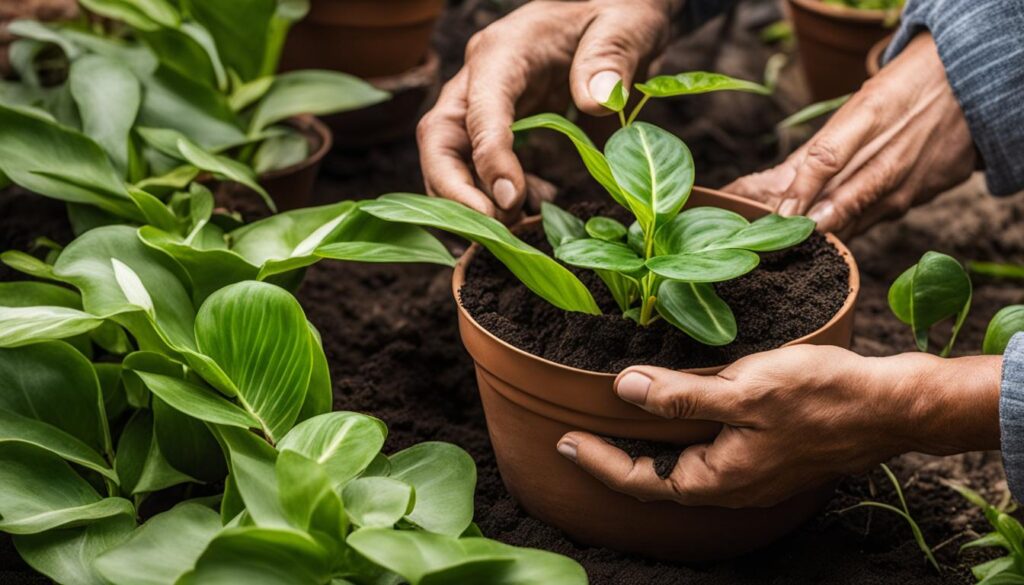Prayer plants, also known as Maranta leuconeura, have captured the hearts of indoor gardeners with their beautiful foliage and unique leaf movements. But have you ever wondered where these fascinating plants come from? In this section, we will delve into the origins of prayer plants and uncover their native habitat.
Key Takeaways:
- Prayer plants are native to the rainforests of Central and South America.
- The name “prayer plant” comes from the plant’s habit of raising and folding its leaves at night.
- These low-growing plants require high humidity and protection from strong sunlight.
- They can be found in countries such as Brazil and thrive in the warm, wet environment of rainforest floors.
- Prayer plants have made their way to domestic gardens worldwide, adding a touch of tropical beauty to interior decor.
Native Habitat of Prayer Plants
Prayer plants, scientifically known as Maranta leuconeura, are native to the lush rainforests of Central and South America. These plants thrive in the natural habitat of the rainforest floor, where they can be found growing amidst the leafy vegetation in the understory. The dense canopy of the rainforest provides a sheltered environment, protecting the prayer plants from direct sunlight. This filtered light is crucial for their growth and overall health.
The rainforest’s warm and wet climate creates an ideal habitat for prayer plants. They have adapted to these conditions and require high levels of humidity to thrive. In their native environment, the air is naturally humid, helping to maintain the moisture that these plants need. Prayer plants have evolved to display vibrant and striking foliage, which is another adaptation to their rainforest habitat.
While prayer plants have made their way into domestic gardens around the world, it is important to replicate their native habitat as much as possible to ensure their well-being. Providing them with a similar environment, including the right levels of humidity and indirect sunlight, will help them flourish in your home or indoor space.
Table: Comparing Native Habitat and Care Needs
| Aspects | Native Habitat | Care Needs |
|---|---|---|
| Light | Filtered and indirect sunlight | Partial shade and protection from direct sun |
| Humidity | High humidity due to rainforest environment | Regular misting or use of a humidifier |
| Temperature | Warm and stable temperatures | Between 65 and 70°F with no sudden temperature changes |
| Soil | Moist and well-draining soil | Consistent watering and well-draining soil mix |
By understanding the native habitat of prayer plants and replicating their care needs, you can create an optimal environment for these beautiful and unique foliage plants. With the right conditions, prayer plants can thrive and bring a touch of the rainforest into your home.
Journey to Domestic Gardens
Prayer plants have embarked on a fascinating journey from their native rainforest habitats in Central and South America to domestic gardens around the world. These captivating plants, known for their striking foliage and unique leaf movements, have found their way into homes and indoor spaces, bringing a touch of tropical beauty to interior decor.
Originally introduced as houseplants, prayer plants have gained popularity due to their mesmerizing leaf patterns and vibrant colors. Through cultivation and propagation, these plants have successfully adapted to diverse regions and climates, allowing them to be grown in various parts of the globe.
So, where do prayer plants originate? They hail from the lush rainforests of Central and South America, specifically the Maranta leuconeura species. From there, they have made their remarkable journey to become cherished additions to home gardens worldwide, captivating plant enthusiasts with their natural beauty and captivating leaf movements.

Prayer plants are not just ordinary houseplants; they are a testament to nature’s diversity and the desire to surround ourselves with the wonders of the rainforest. Whether placed in a living room, office, or bedroom, these plants bring a sense of tranquility and a touch of the exotic to any space.
Light Requirements for Prayer Plants
Light is an essential factor for the proper growth and development of prayer plants. While they require adequate light, it’s important to provide them with the right amount and intensity to avoid damaging their foliage. Prayer plants thrive in partial shade, making them suitable for locations with indirect sunlight. Excessive exposure to direct sun can cause the exceptional leaf color to fade and even scorch the leaves. To ensure optimal growth, it is recommended to place prayer plants near a shady window where they can receive bright, filtered light or protect them from the strongest light with a sheer curtain.
Prayer plants have adapted to the dimly lit understory of rainforests, where they receive dappled sunlight through the dense canopy. This natural habitat provides them with the right balance of light and shade. By replicating this environment in indoor settings, you can help maintain the vibrant colors and prevent leaf damage. Remember, finding the right balance of light is crucial for the health and overall appearance of your prayer plants.
Factors to Consider for Proper Lighting:
- Intensity: Prayer plants prefer moderate to bright, indirect light. Avoid exposing them to direct sunlight, especially during the hottest parts of the day.
- Duration: Ideally, prayer plants should receive 6 to 8 hours of bright, indirect light per day. However, they can tolerate lower light conditions, but growth may be slower.
- Artificial Lighting: If natural light is limited, you can supplement with artificial grow lights that provide the necessary spectrum for photosynthesis.
Prayer plants have a remarkable ability to respond to light changes. The leaves fold up in the evening to form a prayer-like position, hence their name. This unique behavior is their way of protecting their leaves from excessive light exposure and conserving moisture.
Remember, each prayer plant species may have slightly different light requirements, so it’s essential to research the specific needs of your plant. Observing your prayer plant’s response to its current lighting conditions can also provide valuable insights into whether it needs more or less light.
| Light Level | Characteristics |
|---|---|
| Bright Indirect Light | Best for vibrant foliage colors and optimal growth |
| Moderate Indirect Light | Tolerable, but growth may be slower |
| Low Light | Tolerable, but growth may be stunted and foliage color may fade |
Watering and Humidity Needs
Proper watering and humidity levels are crucial for the health and well-being of prayer plants. These tropical beauties require consistent moisture to thrive. During the active growing period from March to September, it is important to keep the soil thoroughly moist. This can be achieved by watering the plant with tepid water whenever the top inch of the potting mix feels dry to the touch. Avoid overwatering, as it can lead to root rot and other issues.
In the winter months, when the plant’s growth slows down, reduce the frequency of watering. Allow the top inch of the soil to dry out before watering again. This will prevent waterlogged conditions and ensure the plant’s roots have enough oxygen.
High humidity is another essential requirement for prayer plants. To mimic their native rainforest environment, it’s important to provide them with adequate moisture in the air. One way to achieve this is by using a pebble tray. Simply place a tray filled with water and pebbles beneath the plant. As the water evaporates, it increases the humidity around the plant. Another option is to mist the foliage daily with water. This will help create a humid microclimate for the prayer plant. In addition, placing the plant in a terrarium or using a humidifier can also help maintain the necessary humidity levels.

By providing the right amount of water and humidity, you can ensure that your prayer plant thrives in its new home. Remember to monitor the soil moisture and adjust your watering schedule accordingly. With the proper care and attention, your prayer plant will reward you with its beautiful foliage and unique leaf movements.
Ideal Temperature Range
Temperature plays a crucial role in the successful cultivation of prayer plants. These tropical beauties thrive in household temperatures between 65 and 70°F (18-21°C). Maintaining a stable temperature within this range is essential for their overall health and growth.
It’s important to note that prayer plants are sensitive to sudden temperature changes. Avoid exposing them to drafts or areas with fluctuating temperatures, as this can cause stress and affect their foliage. Additionally, prayer plants should not be exposed to temperatures below 55°F (13°C), as this can lead to cold damage.
When the temperature rises above the low 60’s, prayer plants have increased humidity needs. Therefore, it’s important to provide adequate moisture levels to mimic their natural rainforest environment. This can be achieved through misting the foliage, using a pebble tray, or utilizing a humidifier.
| Temperature Range | Effect on Prayer Plants |
|---|---|
| Below 55°F (13°C) | Risk of cold damage |
| 55-64°F (13-18°C) | Optimal temperature range |
| 65-70°F (18-21°C) | Preferred temperature range |
| Above 70°F (21°C) | Increased humidity needs |
By maintaining a comfortable temperature range and providing the right humidity levels, you can create an ideal environment for your prayer plants to thrive and showcase their stunning foliage.
Re-potting and Nutrition
Re-potting is an important aspect of caring for prayer plants. These plants should be re-potted every one or two years, preferably in the spring. When re-potting, it is recommended to use a soil-based mixture with added peat and sharp sand. This combination helps keep the soil loose and provides the necessary nutrients for healthy growth.
When re-potting a prayer plant, choose a pot that is slightly larger than the current one to allow room for growth. Gently remove the plant from its current pot, taking care not to damage the roots. Place the plant in the new pot and fill it with the soil mixture, ensuring that the plant is firmly supported.
Nutrition is vital for the overall health and well-being of prayer plants. During the growing period, which typically occurs from March to September, it is important to provide the plants with regular fertilization. A standard liquid fertilizer should be applied every two weeks, following the manufacturer’s instructions. This will ensure that the plants receive the necessary nutrients to thrive and produce vibrant foliage.

Conclusion
Prayer plants, native to the rainforests of Central and South America, have captivated indoor gardeners with their striking foliage and unique leaf movements. These plants, specifically the Maranta leuconeura species, originated in countries such as Brazil. The name “prayer plant” stems from their fascinating habit of raising and folding their leaves at night.
Creating a suitable environment for prayer plants is essential for their growth and well-being. They thrive in partial shade, making them perfect for areas with indirect sunlight. Excessive exposure to direct sun can result in faded leaf color, so it’s important to place them near a shady window or use a sheer curtain to filter the light.
In addition to proper lighting, prayer plants require consistent moisture and high humidity levels. During the growing season, it’s important to keep the soil thoroughly moist with tepid water. In winter, watering should be reduced, allowing the top inch of the potting mix to dry out before watering again. Mimicking their native rainforest habitat, prayer plants benefit from increased humidity achieved through methods such as using a pebble tray, misting the foliage, or placing them in a terrarium or near a humidifier.
With temperatures between 65 and 70°F, prayer plants thrive in the average household climate. It’s crucial to provide a stable temperature and avoid sudden changes that could stress the plants. Re-potting every one or two years, using a soil-based mixture with added peat and sharp sand, helps maintain optimal growth. Regular application of liquid fertilizer during the growing period ensures they receive the necessary nutrients.
FAQ
Where are Prayer Plants from? Discover their Origins
Prayer plants, specifically the Maranta leuconeura species, are native to the rainforests of Central and South America, primarily found in countries such as Brazil.
What is the native habitat of Prayer Plants?
Prayer plants are native to the floor of rainforests in Central and South America. They thrive in the warm, wet environment and can be found growing amongst the leafy vegetation in the understory.
Where do Prayer Plants come from?
Prayer plants have made their way from their native rainforest habitats to domestic gardens around the world. They were first introduced as houseplants and have become popular for their striking foliage and unique leaf movements.
What are the light requirements for Prayer Plants?
Prayer plants thrive in partial shade, making them suitable for locations with indirect sunlight. Excessive exposure to direct sun can cause the exceptional leaf color to fade. It is recommended to place prayer plants near a shady window or protect them from the strongest light with a sheer curtain.
How often should I water and provide humidity for Prayer Plants?
Prayer plants require consistent moisture to thrive. During the growing period from March to September, they should be kept thoroughly moist with tepid water. In winter, reduce watering and allow the top inch of the potting mix to dry out before watering again. Prayer plants also need high humidity levels to mimic their native rainforest environment. Using a pebble tray or misting the foliage daily can help maintain adequate humidity.
What is the ideal temperature range for Prayer Plants?
Prayer plants prefer household temperatures between 65 and 70°F. It is important to avoid sudden temperature changes and ensure that the temperature does not drop below 55°F. In temperatures above the low 60’s, prayer plants have increased humidity needs.
How often should I re-pot and provide nutrition for Prayer Plants?
Prayer plants should be re-potted every one or two years, preferably in spring. A soil-based mixture with added peat and sharp sand is recommended. Standard liquid fertilizer should be applied every two weeks during the growing period to ensure adequate nutrition for the plants.
What are the conclusions about Prayer Plants?
Prayer plants, native to the rainforests of Central and South America, have captivated indoor gardeners with their striking foliage and unique leaf movements. With proper care and attention to their natural habitat, prayer plants can thrive in domestic gardens, bringing a touch of tropical beauty into our homes.









